There has never been an epidemic that has received as much attention as this corona pandemic. Various interested parties have paid attention to it and charged it. Now that we see the last convulsions, on the one hand corona is now being talked about as if it is now a strong cold, but also that "we have to learn to live with corona". So the question is really:Is corona part of life?
A blog by Herman Steigstra and Anton Theunissen
The numbers
Now that the last wave (the autumn Omikron BA.5 wave) is passing by, we think it would be good to take a look at the numbers from a distance. Vaccinations are certainly part of that, but we mainly look at the behaviour and in particular the number of deaths: how many people died over time and what role did corona play in this.
There are various sources that publish figures, of which CBS is the most important. CBS registers deaths via notification forms completed by the general practitioner. On this form, a maximum of three causes can be indicated, which may have had an influence before the death. These figures are published with a delay of 3 months.
Since the beginning of the epidemic, deaths from corona have also been reported by the RIVM. RIVM counts a death from corona if there has been a positive PCR test within two weeks before the death. There is an ever-growing difference between these two organizations, as we have also explained in our articleCBS or RIVM, who has the right figures?We showed here that the RIVM figures in the first year of the epidemic were 40% lower than the CBS figures and seem to be incomplete. The difference has now risen to a factor of 3.5, which is almost 70% lower.
If we bring together the total mortality (all causes) and deaths from corona on the basis of the RIVM figures, we get this graph:
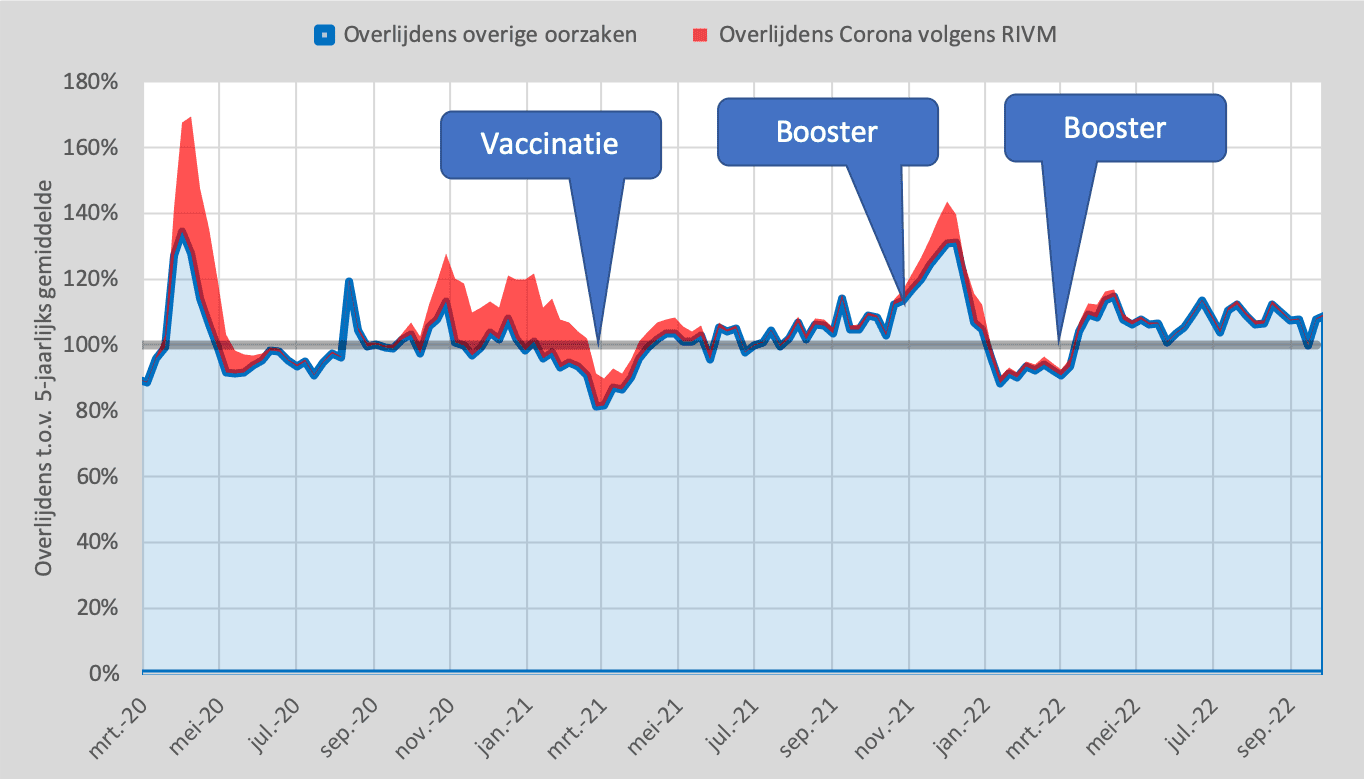
The values per week have been converted into a percentage of what is expected by Statistics Netherlands for that week in terms of deaths on the basis of historical figures (an "intelligent" 5-year average). The red surface is the number of deaths from corona itself, the blue area is what remains for the "Other causes". We can already see here that in the first wave there are almost as many deaths from "Other causes" as from corona itself.
If we use the CBS figures as a measure of the number of deaths from corona, this is a much clearer graph:
We will use this graph to explain the course from the first wave and then refer back to the RIVM figures, to explain the differences.
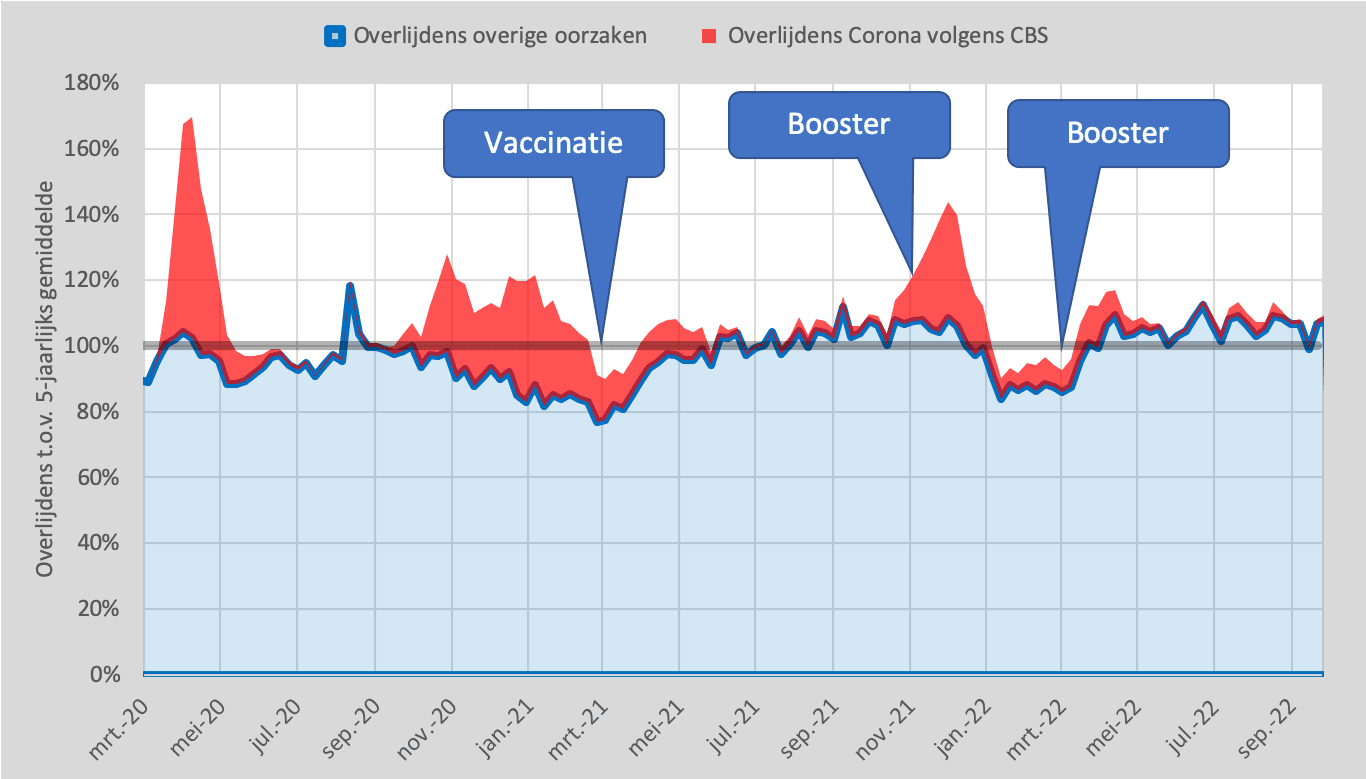
The First Wave
The first wave is actually "out of the book". An exponential increase that led to a large number of deaths within a short time. The rapid increase was caused by the fact that immunity had not yet been built up, allowing the virus to spread quickly. Because people had no resistance, this resulted in many illnesses and deaths. The reproduction number was 2.5 in the run-up to the top. Because social life came to a standstill very quickly (and according to some also due to the influence of the season), the infections also decreased quickly.
What we would like to highlight in particular is the decrease in the number of deaths from other causes. At the end of the first wave, it even dropped below 90%. We see this phenomenon in all respiratory epidemics and corona behaves like a "normal" respiratory epidemic in that respect. This effect is due to the fact that these types of viruses strike mainly in people with poor health and therefore a shorter life expectancy. As a result, they die earlier than if they had not been affected by the virus.
In September 2020, the number of deaths will have returned to normal. However, we still see a small peak in the number of deaths in mid-August, which was the heat wave that killed a number of people.
The Second Wave
The second wave was in fact a continuation of the first wave. Due to the partially built-up immunity and the seasonal effect of 30%, the reproduction number did not exceed 1.3 and a much wider wave emerged than the first ("flatten the curve"). It is clear to see that the number of deaths from "Other causes" is also falling now, even below 80%.
After the vaccinations started in February 2021, we see in March that although the number of deaths from corona is decreasing, the number of deaths from other causes is increasing considerably. Since April, despite the high vaccination coverage, the total number of deaths has risen above 100%. The big question that still hasn't been answered is whether there is a causal link here. Until March 2021, corona behaves like an epidemic from the book, but from April 2021 there seem to be other factors at play and the vaccinations are an obvious candidate.
The number of deaths per week hardly falls below 100%. There is a structural excess mortality, which still persists. We have described this phenomenon in our articleExcess mortality breaks all records.
The Delta wave
In November 2021, the Delta variant will arrive in the Netherlands and it will cause a lot of infections, hospitalizations and of course deaths. In this graph, this interesting part is magnified:
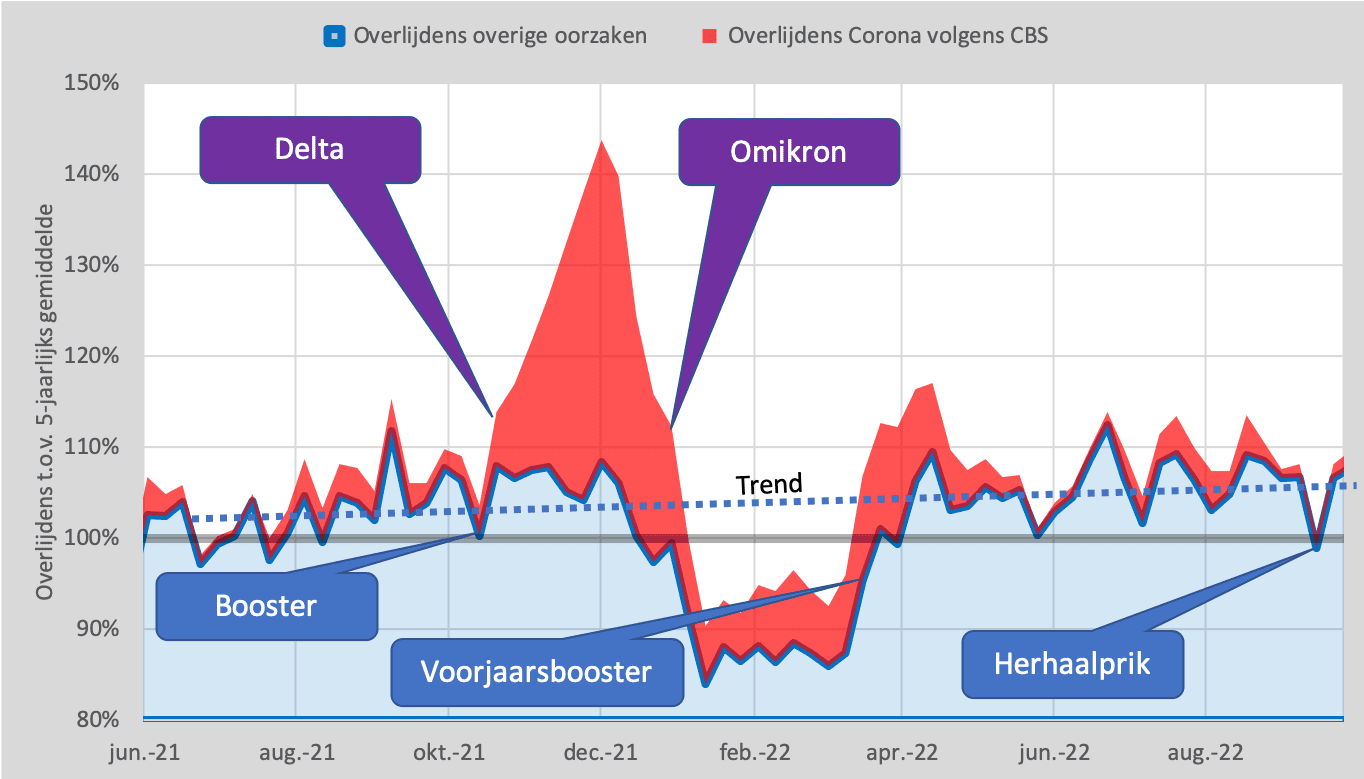
What is striking is that here too, approximately since May 2021, the continuous number of deaths "Other causes" is above 100% and that is strange (the dotted line indicates the trend). In the first and second waves, this number dropped "by the book", but not now! Deaths from other causes have already increased by almost 5% just before the start of the Delta wave.
However, after the Delta wave we see an under-mortality of 15% around the turn of the year. That was when Omikron made his appearance and pushed the Delta away. It remains unclear what influence the booster shot had on the course of the epidemic. In any case, it has not stopped the Delta wave and whether the vaccination is the cause for the unexplained excess mortality during the Delta wave remains an unanswered question. The RIVM figures could give that impression.
If we look at graph 5, based on the RIVM figures, we see a strange picture: deaths from other causes increase much more strongly after the first booster than deaths from corona itself.
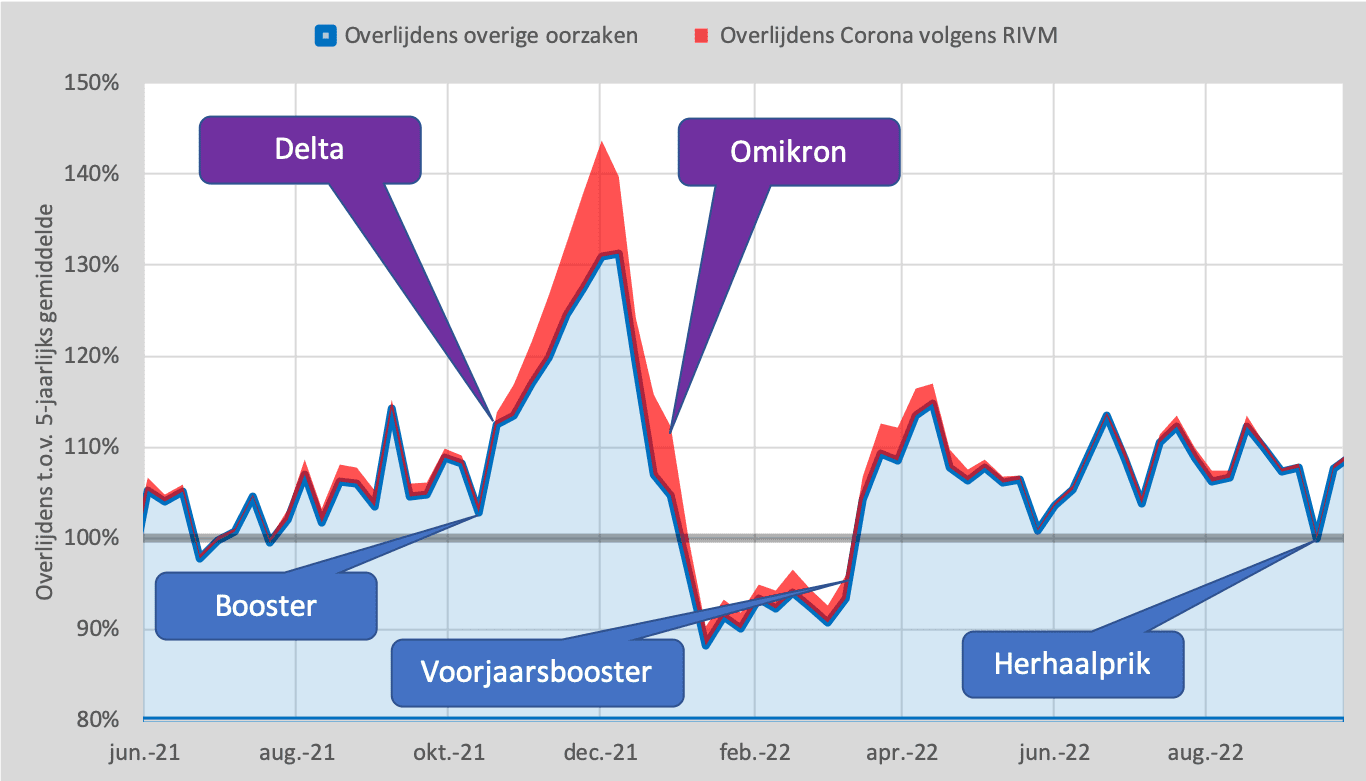
We are probably dealing here with the situation that vulnerable patients with corona die from their underlying suffering, but are not classified as corona patients by the RIVM. In the final death report of the general practitioner to CBS, corona is mentioned as a possible influence on the death. In particular, the fact that the other causes at CBS are not rising makes it plausible that the CBS figures paint a better picture than the RIVM figures. Unless a cause can be found for the sudden increase in mortality on the first booster shot.
After the Delta wave has passed, there is again under-mortality: they are people who died a few months earlier because of the Delta wave. In the meantime, the Omikron variant has also arrived and that actually provided peace on the epidemic level: virtually no more deaths and ICU admissions.
What we then see again is a sudden increase in mortality at the moment the 'spring boosters' were put. The under-mortality rate of 15%, during the first quarter of 2022, turned into an excess mortality of around 10% within a month and it still continues. If we exclude the explainable under-mortality, the trend of May 2021 will continue. The causal link has not been proven, but on the basis of these apparent links we would have expected action much earlier, even if the results had effects on vaccination readiness.
The influenza epidemic that was raging at that time will certainly have played a role, but it was not too long in duration and should have resulted in under-mortality again according to the book, and we have not seen that either. Excess mortality remained.
The Repeat Prick
Since 19 September it is again possible to have a repeat injection. First for the elderly and vulnerable, later for everyone. The big question is what it will mean for mortality rates. The number of corona deaths according to RIVM is currently around 2 per day. Figures from Statistics Netherlands have not yet been published, but could therefore be around 7.
Shortly before the start of the vaccination round, we saw 1 week with 100% of the expected mortality, so no more excess mortality. In the meantime, that has risen again to an excess mortality of around 35 per day, consistent with what we saw in the past year. This is the graph we always keep in the background:
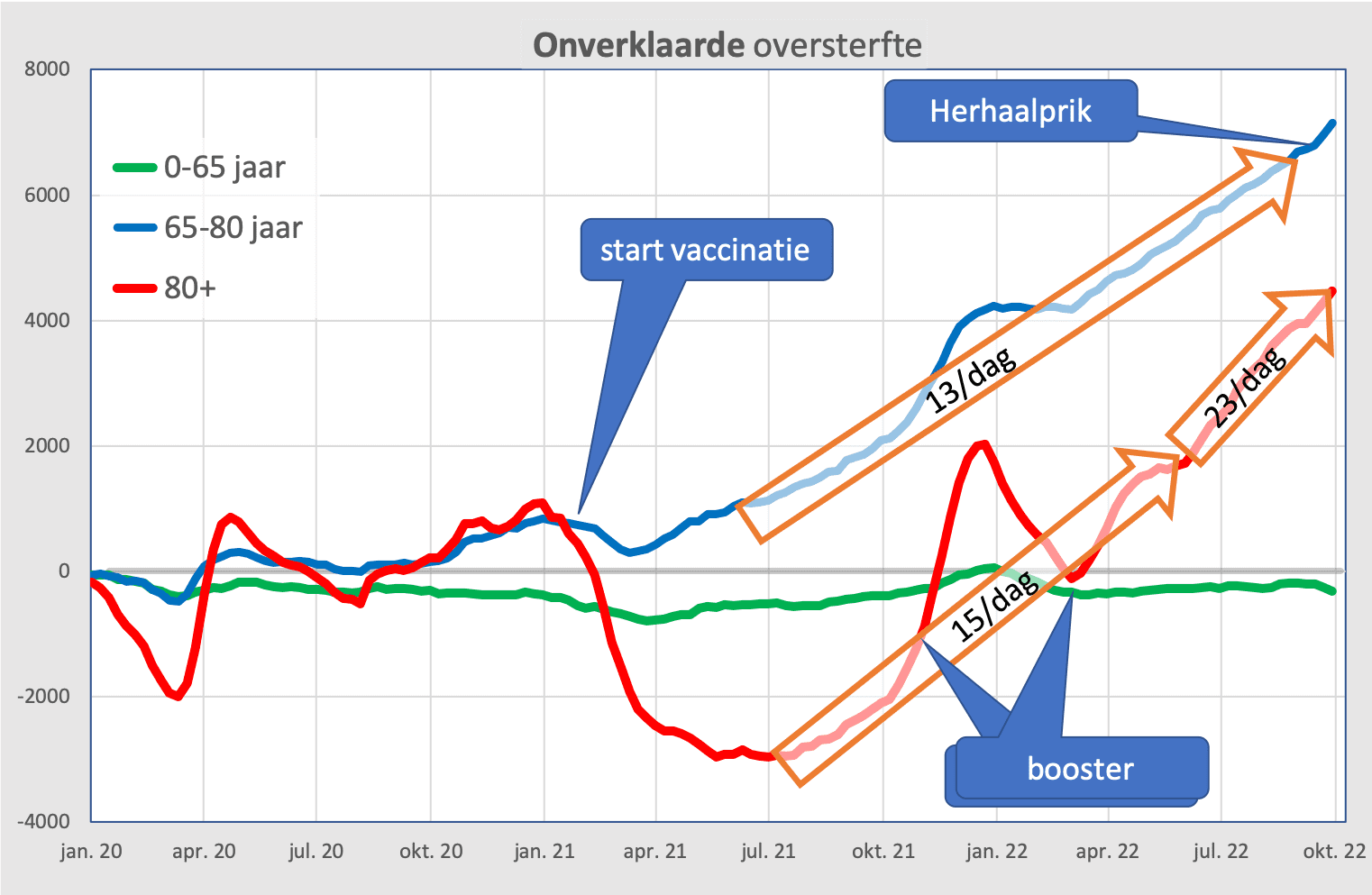
What is special is that the excess mortality under the age of 65 (the group that has not yet had a repeat shot) is now falling, while that above 65 years rises. If the actually have an effect on short-term mortality, then with a low turnout for the repeat prick, that will not be clearly visible. Just as important, however, is whether the rising death trend is continued or, on the contrary, weakened. The coming weeks will give a definite answer!
Conclusions
The corona epidemic actually falls into two parts: before and after vaccination. Until April 2021, corona looks numerically like a big flu looks like. Around 10,000 deaths from the epidemic itself and a corresponding under-mortality that follows. Just as flu is part of life, corona also seems to belong to our lives. However, in this day and age, the fear of the consequences of the epidemic has strongly influenced our lives in a negative sense.
In the second part of the epidemic, we see a different picture. In addition to death from corona itself, we see the picture of persistent excess mortality. Because this image arose after the first round of vaccination and was constantly present in the background (and even seems to be fueled by the booster rounds), the suggestion is made that vaccinations play an important role in this. This causal link has not been proven and additional information on, in particular, the vaccination history of the deceased is essential to demonstrate or exclude this link. The unwillingness of the government to provide this information suggests that it is not in line with the campaigns to increase vaccination readiness.
If we look at the current mortality rates, corona (Omikron) is much milder than a mild flu and falls under the category "belongs to life". Omikron has not caused pressure on healthcare in countries where there was hardly any immunity.
The excess mortality figures are of increasing concern to us. It is important to find out the cause of this. Vaccination seems to be an important cause for this, but we certainly cannot rule out social and societal effects.


Another good piece from Anton. A bit of the same story in other words, but that is also a good thing because then you think again with possibly a different angle.
I do have a comment, Corona and also the Flu are not things that normally belong to life. They are persistent recurrent diseases that cost victims. It is better to be able to cope better with these types of diseases and not just take them for granted every year.
And so it would be to the government's credit to take real measures with regard to health and ventilation in public transport and schools, for example. Or making healthy food cheaper, education, healthier living, etc.
But they don't and so we think it's normal that there are 8,000 and sometimes double the number of deaths from a flu every year. On the highway there are around 700 every year and we find that terrible and that may cost billions to counteract. Or we remove thousands of trees because a person was killed by a branch on the road?
No, a disease, whatever it may be, is not something you have to take for granted, or learn to live with. Learning to live with a disability is not done with something that you can prevent by the right behavior.
And I don't mean a lockdown or other oppressions that actually have a completely different goal.
That's how I look at it, of course.
But I get the message, if the government isn't capable, so your disability, then you have to learn to live with it. (or think further when you choose them)
Agree. It's not one or the other either. Of course, you have to fight disease. Ventilation would make a big difference. But within the limits of what is reasonable. There are standards for it, both in qaly's and budgetaryly. They have all been thrown out the window.
There will always be vulnerable people who do not survive a virus wave. Zero disease is not an option. That is why I feel more for "living with" than for "suffering from the fight against".
The last graph suggests that there is no excess mortality in the age group of 0-65 years. This contradicts the figures from Statistics Netherlands. Over the period 2020 to 2022, I come to an additional mortality of;
2020 ————857
2021 ———-2088
2022WK38—1013
—————–3958 additional mortality
method of calculation;
Statistics Netherlands publishes the mortality figures per week every week.
https://www.cbs.nl/-/media/...
Table 3 shows the deaths per week in column D 0-50 years and in column E 50-65 years.
Table 6 shows the expected number of deaths in the age group of 0-65 years in column S per week .
For example;
week————0-50—50-65–ref.aant.—-increased mortality
2022wk34——120—–328——372————- 76
The sum of the increase and decrease mortality over the whole year comes to the following figures;
2020 ————857
2021 ———-2088
2022WK38—1013
—————–3958 additional mortality
What do you think I'm doing wrong and how do you get your grades?
It is UNEXPLAINED excess mortality. The Corona mortality has therefore been removed, in accordance with the CBS registrations. Could that be it?
So we agree on increased mortality that has not been corrected for corona? A few questions remain. How do you know the corona mortality figures for August, September and October? forecast based on RIVM figures?
How do we know if someone has died from corona or from corona?
Isn't it more objective to measure the health of the population by looking at uncorrected excess mortality?
Hi Mike_S, no figures have been corrected. It is the total (uncorrected) excess mortality minus the (uncorrected) excess mortality declared by corona. Then you have the "unexplained" more / excess mortality.
The last few months have indeed been prognosis based on rivm taking into account the multiplication facor that applied in recent weeks.
On /with corona, cbs keeps that difference against the chest, you should ask them that. I would very much like to know that too.
If you prefer to look at the total excess mortality, that is of course allowed (you can also look at the total mortality). I don't really see why that's more objective. If you do that, you get the response "yes but corona" and then you are back to square one. The 'health of the population', which you mention, is a lot more complicated, both physically and mentally: illness, quality of life, having perspective, experiencing freedom, etc. I don't know if excess mortality 1:1 translates to health. Maybe a lot of healthy people will die suddenly; I don't know.
It's not about right or wrong. You show that there is excess mortality, even if you subtract the covid-19 mortality from the excess mortality. What I want to show is that despite vaccine, excess mortality remains at the same level. CBS is creative in assigning the causes of death of the deceased.
No, I'm not saying it's right or wrong, I thought? But that's fine, then you add up the values again, right? Or you can use the figures directly from CBS. That's what we've done in Excess mortality breaks all records.
Yes, that is an enlightened and frightening article. Excess mortality is only increasing. But there is no need to investigate this in politics.